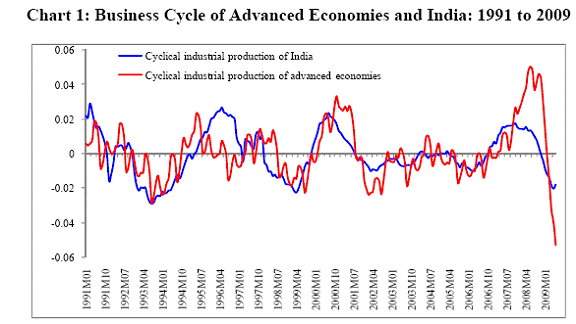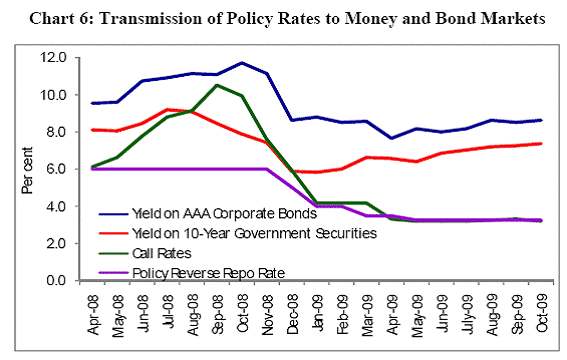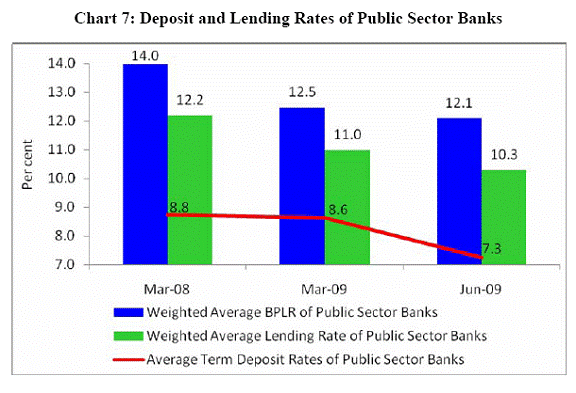I thank ICRIER and InWEnt for giving me this opportunity to speak to you this morning. In my talk, I will try to address the following set of questions: How and why was India impacted by the global financial crisis? How did monetary policy respond to the crisis? What was the impact of the policy on the Reserve Bank’s balance sheet? How did monetary transmission work? I will conclude by highlighting the challenges of exit from monetary easing.
- The subprime crisis that emerged in the US housing mortgage market in 2007 snowballed into a global financial crisis, leading to a global economic recession. The financial landscape has changed significantly after the collapse of Lehman Brothers in September 2008. An important lesson learnt, post-September 2008, is that irrespective of the degree of globalisation of a country and the soundness of its domestic policies, a financial crisis could spread to every economy.
- The international transmission of liquidity shocks was fast and unprecedented. While falling asset prices and uncertainty about valuation of the traded instruments affected market liquidity, failure of leading global financial institutions and the deleveraging process tightened the market for funding liquidity. Given the growing risk of illiquidity cascading into solvency problems, credit and quantitative easing acquired priority in most central banks. The contagion from the global financial crisis warranted swift monetary and fiscal policy responses with a view to ensuring orderly functioning of markets, preserving financial stability, and moderating its adverse effects on growth. While the global financial markets have since started showing signs of stabilisation, credit flow in advanced markets is yet to recover.
How was India Impacted by the Global Financial Crisis?
Transmission of Shocks to India
- There were two distinct phases in 2008-09 during which the transmission of global shocks – through trade, finance and expectations channels – posed different but significant challenges for the Reserve Bank. In the first half of the year, the world experienced simultaneous increase in both food and commodity prices, and there was a return of inflation after a phase of “great moderation”. Dealing with supply side sources of inflation posed challenges for the conduct of the Reserve Bank’s monetary policy, particularly in the face of signs of cyclical slowdown on the one hand and the risk of spiralling headline inflation on the other. In the second half of the year, the global financial crisis and the subsequent global recession dramatically changed the nature of the challenge emanating from globalisation.
Impact on the Financial Markets
- Post-Lehman, the impact of the global financial crisis unfolded in the Indian financial markets, through reversal of capital inflows and significant correction in the domestic stock markets on the back of sell-off in the equity market by the foreign institutional investors (FIIs). The withdrawal of funds from the Indian equity markets and reduced access of the Indian entities to raise funds from the international markets put significant pressure on the dollar liquidity in the domestic foreign exchange market. These developments created adverse expectations on the balance of payments (BoP) outlook leading to downward pressures on the Indian rupee and increased volatility in the foreign exchange market.
- The banking sector was not affected as it had hardly any direct exposure to subprime assets. Moreover, banks were well-capitalised and inherently sound. The reduced foreign funding and the subdued domestic capital market, however, put pressure on some segments of the financial system such as non-bank financial companies (NBFCs) and mutual funds. Mutual funds were dependent on corporates for bulk funds. As liquidity needs of the corporates increased, redemption pressures on mutual funds rose. This translated into liquidity problems for NBFCs as mutual funds were important source of funds to NBFCs. Further, the demand for bank credit also increased as external sources of credit dried up for corporates. Consequently, the pressure for funding liquidity came to rest on the banks. Against this background of increase in demand for liquidity, the Reserve
Bank had to step in with liquidity augmenting measures such as cuts in cash reserve ratio (CRR) and increase in refinance facilities. Aided by liquidity easing measures by the Reserve Bank, the banks continued to expand credit and meet the funds requirements of mutual funds and NBFCs. Initially, though bank credit could not fully offset the shortfall in credit from other sources. Subsequently, demand for bank credit came down as the contagion transmitted to the real economy and eroded private consumption and investment demand.
Impact on the Real Economy
- Under the impact of external demand shocks, the Indian economy witnessed moderation in growth in the second half of 2008-09 in comparison with the robust growth performance in the preceding five years (8.8 per cent per annum). The deceleration in growth was particularly noticeable in negative growth in industrial output in Q4 of 2008-09 – a decline for the first time since the mid-1990s (Table 1). This was on account of erosion of external demand which affected industrial performance – a reflection of increasing globalisation of the Indian industry.
Table 1: Key Macroeconomic Indicators - India |
Indicators |
2008-09: Q1-Q4 |
2009-10: Q1-Q2 |
|
Q1 |
Q2 |
Q3 |
Q4 |
Q1 |
Q2 |
Real GDP Growth (Y-o-Y) (%) |
7.8 |
7.7 |
5.8 |
5.8 |
6.1 |
- |
Industry |
5.1 |
4.8 |
1.6 |
-0.5 |
4.2 |
- |
Services |
10.0 |
9.8 |
9.5 |
8.4 |
7.7 |
- |
Inflation (Y-o-Y) (%) |
|
|
|
|
|
|
WPI |
12.0 |
12.1 |
5.9 |
0.8 |
-1.1 |
-0.2 |
CPI-Industrial Workers |
7.7 |
9.8 |
9.7 |
8.0 |
9.3 |
11.8 |
Money and Credit Growth
(Y-o-Y) (%) |
|
|
|
|
|
|
Broad Money (M3) |
21.5 |
19.5 |
19.9 |
18.6 |
20.2 |
19.7 |
Banks Credit |
24.5 |
23.5 |
22.7 |
16.4 |
15.1 |
14.1 |
Interest Rates (%) |
|
|
|
|
|
|
Overnight (call) money |
6.8 |
9.5 |
7.8 |
4.2 |
3.2 |
3.2 |
10-year g-sec |
8.4 |
8.5 |
5.9 |
6.6 |
6.8 |
7.1 |
Foreign Trade |
|
|
|
|
|
|
Export Growth (%) |
37.6 |
39.5 |
-15.0 |
-22.3 |
-30.0 |
-21.0 |
Import Growth (%) |
31.6 |
60.5 |
2.1 |
-29.1 |
-35.0 |
-33.6 |
Balance of Payments
(US $ billion) |
|
|
|
|
|
|
Trade Deficit (-) |
-31.4 |
-38.7 |
-34.7 |
-14.6 |
-26.0 |
- |
Current Account Deficit (-) |
-9.0 |
-12.5 |
-13.0 |
4.7 |
-5.8 |
- |
Net Capital Flows |
11.1 |
7.6 |
-4.3 |
-5.3 |
6.7 |
- |
Reserve Outstanding |
312.1 |
286.3 |
256.0 |
252.0 |
265.1 |
281.3 |
- The transmission of external demand shocks was swift and severe on export growth, which deteriorated from a peak rate of about 40 per cent in Q2 of 2008-09 to (-) 15 per cent in Q3 and further to (-) 22 per cent in Q4 – a contraction for the first time since 2001-02. Concurrently, domestic aggregate demand also moderated resulting from sharp deceleration in the growth of private consumption demand. In order to respond to the slowing demand, fiscal stimulus measures were undertaken by the government which included both tax cuts and increase in expenditure. This raised the fiscal deficit of the Central Government by 3.5 per cent of GDP in 2008-09. Consequently, the growth in government final consumption expenditure registered a sharp increase in Q3 and Q4 of 2008-09 (Table 2). It is, however, important to note that unlike many countries the entire fiscal stimulus in India was aimed at addressing the deficiency in aggregate demand rather than extending support to the financial sector. While this meant a deviation from the planned fiscal consolidation path as committed under the Fiscal Responsibility and Budget Management (FRBM) Act, without the stimulus the deceleration in GDP growth during 2008-09 would have been much sharper.
Table 2: Components of Aggregate Demand in India |
(Per cent) |
Item |
2008-09 |
2009-10 |
Q1 |
Q2 |
Q3 |
Q4 |
Q1 |
Growth Rates (Year-on-Year) |
|
|
|
|
|
Private Final Consumption Expenditure |
4.5 |
2.1 |
2.3 |
2.7 |
1.6 |
Government Final Consumption Expenditure |
-0.2 |
2.2 |
56.6 |
21.5 |
10.2 |
Gross Fixed Capital Formation |
9.2 |
12.5 |
5.1 |
6.4 |
4.2 |
Change in Stocks |
6.0 |
5.6 |
1.4 |
-0.9 |
3.2 |
Exports |
25.6 |
24.3 |
7.1 |
-0.8 |
-10.9 |
Less Imports |
27.4 |
35.3 |
21.7 |
-5.7 |
-21.2 |
Relative shares |
|
|
|
|
|
Private Final Consumption Expenditure |
58.0 |
55.5 |
57.4 |
51.4 |
55.6 |
Government Final Consumption Expenditure |
9.6 |
8.3 |
12.5 |
13.4 |
9.9 |
Gross Fixed Capital Formation |
32.2 |
34.5 |
30.9 |
31.6 |
31.6 |
Change in Stocks |
3.2 |
3.2 |
2.9 |
2.9 |
3.1 |
Net Exports |
-1.3 |
-10.5 |
-8.5 |
-2.9 |
1.6 |
Source: Central Statistical Organisation. |
Why was India Impacted by the Global Financial Crisis?
- During the initial phases of the global crisis, the Indian financial markets remained unaffected as the direct exposure of banks to global subprime assets was negligible. The growth process, being largely domestic demand driven, remained broadly intact. It was then perceived that India and other EMEs were ‘decoupled’ from the advanced economies. As indicated by Governor Dr.Subbarao “the ‘decoupling theory’ was never totally persuasive”.1 As the crisis intensified, particularly after the Lehman collapse, the global shocks first impacted the domestic financial markets and then transmitted to the real economy through the trade, finance and confidence channels.
- Despite the dominance of domestic demand, the role of trade in conditioning the growth process in India is becoming important over time. A significant boost to global integration came through rapid growth in India’s international trade in services in the 2000s enabled by expansion in information technology which facilitated cross-border delivery of services. Progressive liberalisation of capital account, initiated in the 1990s and continued through the 2000s, gave further fillip to the process of financial integration. Thus, the financial channel emerged as dominant factor with gross capital flows (inflows plus outflows) rising to over 50 per cent of GDP in 2008-09 from an average of about 5 per cent in the 1980s (Table 3). Given the significant degree of openness achieved since the 1990s, it is natural that the global shocks – real as well as financial –have greater impact.
Table 3: Key Indicators of Openness of the Indian Economy |
(Per cent of GDP) |
Year |
Goods Trade |
Services Trade |
Gross Current Account |
Gross Capital Account |
Gross Current
and Capital Account |
1 |
2 |
3 |
4 |
5 |
6 |
1970s |
10.0 |
1.3 |
12.7 |
4.2 |
16.9 |
1980s |
12.7 |
2.5 |
17.2 |
5.4 |
22.6 |
1990s |
18.8 |
4.1 |
26.7 |
15.1 |
41.8 |
2000s
(2000-09) |
29.4 |
9.8 |
45.1 |
32.8 |
77.9 |
2008-09 |
40.6 |
13.1 |
61.0 |
51.5 |
112.4 |
- With increased global integration, the Indian economy now is subject to greater influence of global business cycles. The correlation between the cyclical component of the index of industrial production (IIP) of the advanced economies and India has risen to 0.50 during the period 1991-2009 from 0.20 in during the period 1971-1990 (Chart 1).
- The traditional conduit of transmission of global shocks is through trade cycles. The cyclical movement in India’s exports and world imports during the earlier period 1970-91 was not significantly synchronised with a relatively low correlation of 0.38. However, with rising exports alongwith a transition from primary article exports to manufacturing exports, the correlation between India’s exports and world imports has increased significantly to 0.80 during the recent period 1992-2009 (Chart 2).
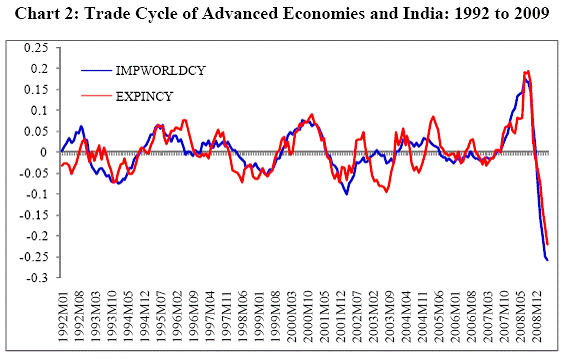 |
- Besides the synchronisation of the trade cycles, the financial channel of integration has also become prominent during the recent period. A causal analysis between the cyclical component of the Indian stock prices (BSE Sensex) and the US stock prices (S&P 500 Index) reveals that during the earlier period (1970-1991), when foreign investors could not participate in the Indian stock market, there was no causal effect of the global stock prices on the Indian markets. However, in the recent period (1992-2009), there has been greater impact from the global stock prices on domestic stock prices with the US stock prices having significant causal impact on the Indian stock prices (Table 4).
Table 4: Causality between the Cyclical Components of the Indian
and the US stock prices |
Null Hypothesis |
F-Statistic |
Result |
Sample: 1970M01 1991M12 |
|
|
BSE Index does not Granger Cause S&P500 |
1.89 |
Accept |
S&P500 does not Granger Cause BSE Index |
0.48 |
Accept |
Sample: 1992M01 2009M06 |
|
|
BSE Index does not Granger Cause S&P500 |
0.36 |
Accept |
S&P500 does not Granger Cause BSE Index |
4.80 |
Reject |
- These shifts in the degree of synchronisation of the Indian trade and business cycles with the global cycles and increased financial integration in the recent period indicate that India cannot remain immune to global trends. Thus, global economic developments now have a greater influence on the domestic economy.
How did Monetary Policy in India Respond to the Global Financial Crisis?
- As the crisis intensified, the Reserve Bank of India, like most central banks, took a number of conventional and unconventional measures to augment domestic and foreign exchange liquidity, and sharply reduced the policy rates. In a span of seven months between October 2008 and April 2009, there was unprecedented policy activism. For example: (i) the repo rate was reduced by 425 basis points to 4.75 per cent, (ii) the reverse repo rate was reduced by 275 basis points to 3.25 per cent, (iii) the cash reserve ratio (CRR) was reduced by a cumulative 400 basis points to 5.0 per cent, and (iv) the actual/potential provision of primary liquidity was of the order of Rs. 5.6 trillion (10.5 per cent of GDP).
- There are, however, some key differences between the actions taken by the Reserve Bank of India and the central banks in many advanced countries:
First, in the process of liquidity injection the counter-parties involved were banks; even liquidity measures for mutual funds, NBFCs and housing finance companies were largely channeled through the banks.
Second, there was no dilution of collateral standards which were largely government securities, unlike the mortgage securities and commercial papers in the advanced economies.
Third, despite large liquidity injection, the Reserve Bank’s balance sheet did not show unusual increase, unlike global trend, because of release of earlier sterilised liquidity.
Fourth, availability and deployment of multiple instruments facilitated better sequencing of monetary and liquidity measures.
Finally, the experience in the use of procyclical provisioning norms and counter-cyclical regulations ahead of the global crisis helped enhance financial stability.
- By synchronising the liquidity management operations with those of exchange rate management and non-disruptive internal debt management operations, the Reserve Bank of India ensured that appropriate liquidity was maintained in the system, consistent with the objective of price and financial stability. The policy stance clearly reflected the forward looking undertone, particularly the expectations of more prolonged adverse external conditions in the face of no visible risks to inflation. While the magnitude of the crisis was global in nature, the policy responses were adapted to domestic growth, inflation and financial sector conditions.
How did Crisis Management Change the Reserve Bank’s Balance Sheet?
- As the balance of payments came under pressure in Q3 of 2008-09 due to capital outflows, it became necessary to draw down reserves to finance the shortfall and maintain orderly conditions in the foreign exchange market. This led to corresponding contraction in the base (reserve) money. The Reserve Bank, therefore, ensured the necessary expansion in net domestic assets (NDA) through conventional open market operations (OMO) involving outright purchase of government securities in the secondary market as well as provision of liquidity through repos under its daily liquidity adjustment facility (LAF) (Chart 3). Another instrument which allowed the Reserve Bank of India to expand liquidity was the unwinding of the market stabilisation scheme (MSS) securities.2 The unwinding of MSS balances not only created the scope for adequate liquidity expansion by the Reserve Bank without expanding its balance sheet (Chart 4) in any significant measure, but the timing of the unwinding could also be modulated in such a way that the large borrowing programme of the government was managed smoothly without exerting undue market stress. In addition, the reduction in CRR of banks from 9 per cent to 5 per cent released Rs.1.6 trillion of primary liquidity to the banking system.
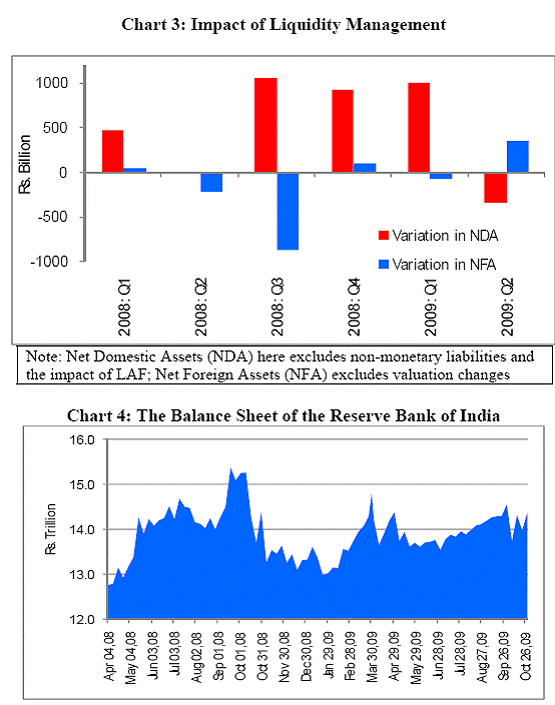 |
- While the Reserve Bank’s balance sheet did not show unusual expansion, sharp reductions in CRR raised the money multiplier, leading to higher increase in broad money.3 The average money multiplier rose from 4.3 in March 2008 to 4.8 in March 2009, reflecting lowering of CRR (Chart 5). The increase in money multiplier ensured steady increase in money supply consistent with the liquidity requirements of the economy.
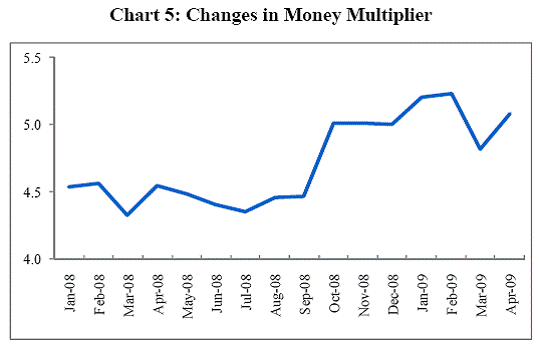 |
- The liquidity injection efforts of the Reserve Bank, despite being large, could be achieved without compromising either on the eligible counterparties or on the asset quality in the Reserve Bank’s balance sheet. The liquidity requirements of non-bank financial entities were met indirectly by extending liquidity support to the designated counterparties like scheduled commercial banks and primary dealers. Liquidity expansion achieved through unwinding of MSS and reduction in reserve requirement ensured that the Reserve Bank’s balance sheet did not expand significantly, unlike in several other central banks.
How did Monetary Transmission Work?
- In the wake of the crisis, monetary transmission broke down in several countries as risk aversion gave rise to credit crunch. As regards India, the changes in the Reserve Bank’s policy rates were quickly transmitted to the money and debt markets (Chart 6). The money market rates moved in tandem with the policy reverse repo rate. However, transmission to the credit market was slow due to several structural rigidities in the system, especially the dominance of fixed term deposit liabilities in banks’ balance sheets at fixed interest rates.
- As bank deposits contracted in the past at high rates have started to mature and banks have significantly reduced their term deposit rates, the transmission of lower policy rates to the credit market has improved with a lag (Chart 7).
What are the Challenges of Exit from Monetary Easing?
- There is an active debate on the timing and sequencing of expansionary monetary stance around the world. In this context, Governor Dr. Subbarao, in his J.R.D. Tata Memorial Lecture4 had indicated that the current monetary and fiscal stance is not the steady state. The exit from the current monetary policy accommodation could, however, be different across countries depending on the balance of risk to growth and price stability, types of balance sheet adjustment that have taken place during the crisis and the position of the economy in the business cycle. In the case of advanced countries, where central bank balance sheets have expanded substantially including the portfolio comprising mortgage-backed securities, commercial papers and corporate bonds, the exit policies may be constrained by the speed of revival and developments in the specific market segments. In contrast, the central bank accommodation in India was mainly done through unwinding of MSS and conduct of OMO including LAF and through special refinancing facilities in the banking system. Thus, the withdrawal of monetary accommodation in India should be feasible without adverse impact on specific market segments.
- The October 2009 Review of Monetary Policy for the Year 2009-10 brought forward the challenges. To quote:
“The precise challenge for the Reserve Bank is to support the recovery process without compromising on price stability. This calls for a careful management of trade-offs. Growth drivers warrant a delayed exit, while inflation concerns call for an early exit. Premature exit will derail the fragile growth, but a delayed exit can potentially engender inflation expectations…. The balance of judgment at the current juncture is that it may be appropriate to sequence the ‘exit’ in a calibrated way so that while the recovery process is not hampered, inflation expectations remain anchored. The ‘exit’ process can begin with the closure of some special liquidity support measures.”
Accordingly, the Reserve Bank has begun the first phase of ‘exit’, by withdrawal of most of the unconventional measure taken during the crisis.
Conclusion
- To sum up, despite sound fundamentals and no direct exposure to the sub-prime assets, India was affected by global financial crisis reflecting increasing globalisation of the Indian economy. The policy response has been swift. While fiscal stimulus cushioned the deficiency in demand, monetary policy augmented both domestic and foreign exchange liquidity. The expansionary policy stance of the Reserve Bank was manifested in significant reduction in CRR as well as the policy rates. The contraction of the Reserve Bank’s balance sheet resulting from the decline in its foreign assets necessitated active liquidity management aimed at expanding domestic assets, which was ensured through OMO including regular operations under the LAF, unwinding of MSS securities, introduction of new and scaling up of existing refinance facilities. In addition, sharp reductions in CRR besides making available primary liquidity raised the money multiplier and ensured steady increase in money supply. The liquidity injection efforts of the Reserve Bank could be achieved without compromising either on the eligible counterparties or on the asset quality in the Reserve Bank’s balance sheet. Moreover, the Reserve Bank’s balance sheet did not show any unusual increase, unlike that of several other central banks.
- At present, the focus around the world and also in India has shifted from managing the crisis to managing the recovery. The key challenge relates to the exit strategy that needs to be designed, considering that the recovery is as yet fragile but there is an uptick in inflation, though largely from the supply side, which could engender inflationary expectations. Thus, the Reserve Bank has initiated the first phase of exit in its October 2009 Review of monetary policy in a calibrated manner mainly by withdrawal of unconventional measures taken during the crisis. This should help anchor inflationary expectations by reducing the overhang of liquidity without jeopardising the growth process as market liquidity remains comfortable.
Thank you.
* Speech delivered by Deepak Mohanty, Executive Director, Reserve Bank of India at the 3rd ICRIER-InWEnt Annual Conference on 12th November, 2009 at New Delhi. The assistance provided by Shri Bhupal Singh is gratefully acknowledged.
1 Dr. D. Subbarao (2008), “Mitigating Spillovers and Contagion – Lessons from the Global Financial Crisis”, Speech delivered at the RBI-BIS Seminar at Hyderabad on December 4, 2008.
2MSS securities are essentially short-term government securities, introduced in April 2004, as an instrument of sterilisation to partly neutralise the expansionary effects of surges in capital inflows. The amount sterilised through MSS remained immobilised in the Central Government’s account with the Reserve Bank of India. As at end-September 2008, MSS amount stood over Rs. 1.7 trillion.
3 Money Multiplier can be expressed as [1+c]/(c+r], where, c is currency-deposit ratio (a behavioural variable) and r is reserve requirement ratio (a policy variable). A reduction in r leads to an increase in the money multiplier
4 Dr. D. Subbarao (2009), “Global Financial Crisis Questioning the Questions” Speech delivered at the JRD Tata Memorial Lecture at the meeting of The Associated Chambers of Commerce and Industry of India, New Delhi on July 31, 2009. |













